|
 OIL YIELD BASICS
OIL YIELD BASICS
Oil shales come in two
flavours, those with immature kerogen and those with mature
kerogen. In the immature case, the kerogen has not yet been
converted to liquid oil, so the kerogen must be matured in
situ or in a surface facility by the use of heat. A muture
oil shale has liquid hydrocarbons and are often termed
"tight oil" plays.
For immature oil shales, rock
samples are analyzed in the laboratory using a process
called Fuscher analysis, giving an oil yield in US gallons
per ton of rock. Mature oil shales are analyzed using
conventional core analysis coupled with standard geochemical
and total organic carbon analysis.
 IMMATURE OIL Shale BAsics
IMMATURE OIL Shale BAsics
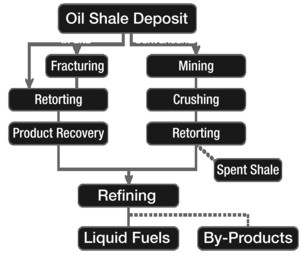 The immature oil shale case is shown on the rest of this
web page. See
tight oil plays for the mature
kerogen special case., The immature oil shale case is shown on the rest of this
web page. See
tight oil plays for the mature
kerogen special case.,
The
distinguishing characteristic of an immature "oil shale" is that it
contains significant organic carbon but no free oil or gas. This hydrocarbon is
immature, not yet transformed into oil by natural processes, and are usually termed
"source rocks". Some adsorbed and some free gas may also exist.
Immature oil shales require a specialized log analysis model because the
Archie saturation model is often inappropriate.
Immature oil shale can be mined on the surface or
at depth and the rock heated in a retort to convert the organic
content to oil. Some valuable by products such as vanadium may
also be extracted, but dry clay, ash, and other minerals are a
serious waste disposal issue. In-situ extraction using
super-heated steam, air, carbon dioxide, or some other heat
transfer system is used to convert the organic carbon to oil.
Collector wells then extract the oil.
Immature oil shales have been exploited since the mid 1800's. An
interesting radio show gives a brief history and an over-hyped
future for the Colorado -Utah-Wyoming immature oil shales as
seen from the post-war perspective of 1946. Click
HERE to listen.
You can fast-forward over the first 5 minutes to avoid some
really bad scene-setting dialogue. And they "forgot" to mention
that Canada was the first to commercially produce kerosene from
shale oil in 1846.
 CLASSIFYING OIL Shale
CLASSIFYING OIL Shale
Immature oil shale has received many
different names over the years, such as cannel coal, boghead
coal, alum shale, stellarite, albertite, kerosene shale,
bituminite, gas coal, algal coal, wollongite, schistes
bitumineux, torbanite, and kukersite. Some of these names are
still used for certain types of oil shale. Recently, however,
attempts have been made to systematically classify the many
different types of oil shale on the basis of the depositional
environment of the deposit, the petrographic character of the
organic matter, and the precursor organisms from which the
organic matter was derived.
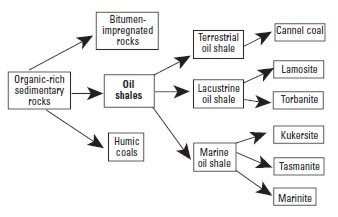 A
useful classification of oil shales was developed by A.C.
Hutton. He divided oil shale into three groups based on their
deposition environment: terrestrial, lacustrine, and marine, and
further by the origin of their organic matter. A
useful classification of oil shales was developed by A.C.
Hutton. He divided oil shale into three groups based on their
deposition environment: terrestrial, lacustrine, and marine, and
further by the origin of their organic matter.
Terrestrial oil shales include those
composed of lipid-rich organic matter such as resin spores, waxy
cuticles, and corky tissue of roots and stems of vascular
terrestrial plants commonly found in coal-forming swamps and
bogs. Lacustrine oil shales include organic matter derived from
algae that lived in fresh, brackish, or saline lakes. Marine oil
shales are composed of organic matter derived from marine algae
unicellular organisms, and marine dinoflagellates.
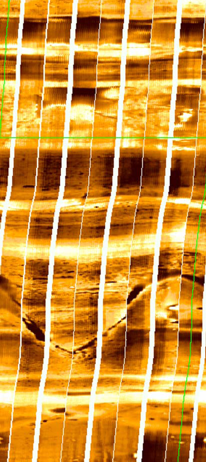  Resistivity image log in lacustrine
oil shale. White is high resistivity, black is low resistivity. Resistivity image log in lacustrine
oil shale. White is high resistivity, black is low resistivity.
Within
these three groups, Hutton recognized six specific oil-shale
types, as shown in the diagram above:
1. Cannel coal is
brown to black oil shale composed of resins, spores, waxes, and
cutinaceous and corky materials derived from terrestrial
vascular plants together with varied amounts of vitrinite and
inertinite. Cannel coals originate in oxygen-deficient ponds or
shallow lakes in peat-forming swamps and bogs.
2. Lamosite is pale, grayish-brown and dark gray to black oil
shale in which the chief organic constituent is lamalginite
derived from lacustrine planktonic algae. Other minor components
include vitrinite, inertinite, telalginite, and bitumen. The
Green River oil-shale deposits in western United States and a
number of the Tertiary lacustrine deposits in eastern
Queensland, Australia, are lamosites.
3. Marinite is a gray to dark gray to black oil shale of
marine origin in which the chief organic components are
lamalginite and bituminite derived chiefly from marine
phytoplankton. Marinite may also contain small amounts of
bitumen, telalginite, and vitrinite. Marinites are deposited
typically in epeiric seas such as on broad shallow marine
shelves or inland seas where wave action is restricted and
currents are minimal. The Devonian–Mississippian oil shales of
eastern United States are typical marinites. Such deposits are
generally widespread covering hundreds to thousands of square
kilometers, but they are relatively thin, often less than 100 m.
4. Torbanite, named
after Torbane Hill in Scotland, is a black oil shale whose
organic matter is composed mainly of telalginite found in fresh-
to brackish-water lakes. The deposits are commonly small, but
can be extremely high grade.
5. Tasmanite, named
from oil-shale deposits in Tasmania, is a brown to black oil
shale. The organic matter consists of telalginite derived
chiefly from unicellular algae of marine origin and lesser
amounts of vitrinite, lamalginite, and inertinite.
6. Kukersite, which
takes its name from Kukruse Manor near the town of Kohtla-Järve,
Estonia, is a light brown marine oil shale. Its principal
organic component is telalginite derived from green algae.
Kukersdite is the main type of oil shale in Estonia and westtern
Russiaa, and is burned instead of coal to generate
electricity in power plants.
 OIL Shale IN CANADA
OIL Shale IN CANADA
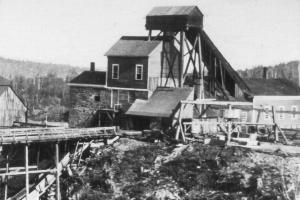 Canada
produced some shale oil from deposits in New Brunswick in the
mid-1800's. The mineral was called
Albertite and was originally believed to be a form of coal. Canada
produced some shale oil from deposits in New Brunswick in the
mid-1800's. The mineral was called
Albertite and was originally believed to be a form of coal.
 Albert Mines, New Brunswick, in 1850's Albert Mines, New Brunswick, in 1850's
Later, the nature of
the mineral and its relation to the surrounding oil shale was
described correctly. Abraham Gesner used Albertite in his early
experiments to distill liquid fuel from coal and solid bitumen.
He is credited with the invention of kerosene in 1846, and built
a significant commercial distillery to provide lighting oil to
replace whale oil in eastern Canada and USA. In the 1880's,
shale oil was abandoned as a source of kerosene in favour of
distillation from liquid petroleum.
Canada's oil-shale deposits range from
Ordovician to Cretaceous age and include deposits of lacustrine
and marine origin in at least 20 locations across the country.
During the 1980s, a number of the deposits were explored by core
drilling. The oil shales of the New Brunswick Albert Formation,
lamosites of Mississippian age, have the greatest potential for
development. The Albert oil shale averages 100 l/t of shale oil
and has potential for recovery of oil and may also be used for
co-combustion with coal for electric power generation.
Marinites, including the Devonian Kettle Point Formation and the
Ordovician Collingwood Shale of southern Ontario, yield
relatively small amounts of shale oil (about 40 l/t), but the
yield can be doubled by hydroretorting. The Cretaceous Boyne and
Favel marinites form large resources of low-grade oil shale in
the Prairie Provinces of Manitoba, Saskatchewan, and Alberta.
Upper Cretaceous oil shales on the Anderson Plain and the
Mackenzie Delta in the Northwest Territories have been little
explored, but may be of future economic interest.
 Determining OIL YIELD (Grade) of
Oil Shale FROM ROCK SAMPLES
Determining OIL YIELD (Grade) of
Oil Shale FROM ROCK SAMPLES
The grade of oil shale has been determined by many
different methods with the results expressed in a variety of
units. The heating value of the oil shale may be determined
using a calorimeter. Values obtained by this method are reported
in English or metric units, such as British thermal units (Btu)
per pound of oil shale, calories per gram (cal/gm) of rock,
kilocalories per kilogram (kcal/kg) of rock, megajoules per
kilogram (MJ/kg) of rock, and other units.
The heating value is useful for determining the quality of an
oil shale that is burned directly in a power plant to produce
electricity. Although the heating value of a given oil shale is
a useful and fundamental property of the rock, it does not
provide information on the amounts of shale oil or combustible
gas that would be yielded by retorting (destructive
distillation).
The grade of oil shale can be determined by measuring the yield
of oil of a shale sample in a laboratory retort. The method
commonly used in Canada and United States is called the modified
Fischer assay, first developed in Germany, then adapted by the
U.S. Bureau of Mines. The technique was subsequently
standardized as the ASTM Method D-3904-80. Some laboratories
have further modified the Fischer assay method to better
evaluate different types of oil shale and different methods of
oil-shale processing.
The standardized Fischer assay consists of heating a 100-gram
sample crushed to –8 mesh (2.38-mm mesh) screen in a small
aluminum retort to 500ºC at a rate of 12ºC per minute and held
at that temperature for 40 minutes. The distilled vapors of oil,
gas, and water are passed through a condenser cooled with ice
water into a graduated centrifuge tube. The oil and water are
then separated by centrifuging. The quantities reported are the
weight percent of shale oil, water, shale residue, and “gas plus
loss” by difference. Some organic matter is turned to char and
reported as part of the shale residue. As a result, this assay
may understate the amount of oil that might be recovered in a
commercial scale retort that continuously mixes the feedstock.
Oil yield is usually converted from mass fraction into US or
Imperial gallons per ton (gpt or gal/t) of rock. So much for
going metric! In Canada, oil yields are quoted in liters per
metric ton of rock (l/t).
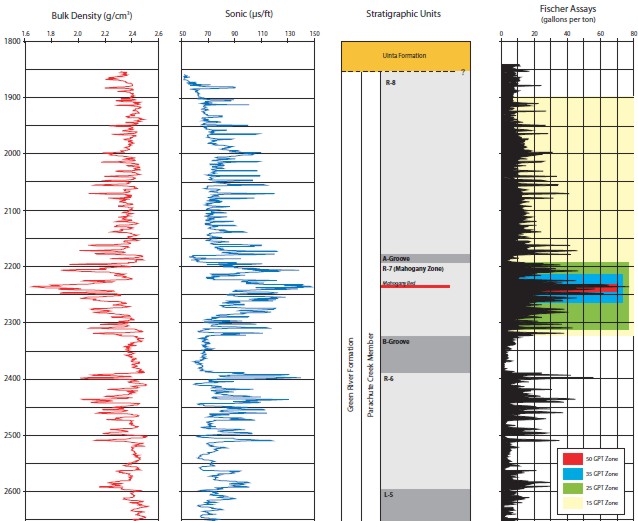
Oil shale example from Utah; density log (left), sonic (middle,
Fischer oil yield in gallons/ton (right). Note sonic scale is
reverse of conventional oilfield practice. Low density and high
sonic travel time correspond to high oil yield, analogous to
high porosity in conventional oilfield applications.
|


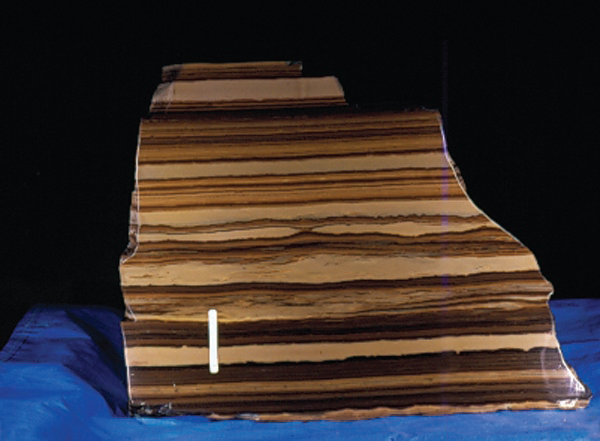
 The immature oil shale case is shown on the rest of this
web page. See
The immature oil shale case is shown on the rest of this
web page. See
 A
useful classification of oil shales was developed by A.C.
Hutton. He divided oil shale into three groups based on their
deposition environment: terrestrial, lacustrine, and marine, and
further by the origin of their organic matter.
A
useful classification of oil shales was developed by A.C.
Hutton. He divided oil shale into three groups based on their
deposition environment: terrestrial, lacustrine, and marine, and
further by the origin of their organic matter.
 Canada
Canada